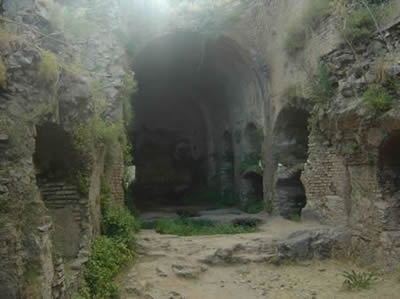Traveler's Guide
East Macedonia & Thrace
Gold mines Stremtsi

These are unique golden mines built in ancient times. Their total length is 460 meters. The galleries look like a labyrinth; hence their name. Unil 1980 they were thought to be a Thracian sanctuary or the graveyard of a powerful possessor from Edrine.One characteristic feature of the population from the Rhodope Mountains in those days was the cult of Dionysus. Another was the mining of gold, silver and precious metals.
The Golden mines by Stremtsi village were one of the biggest in the ancient world. They still impress the visitor with their hundred-meter long galleries, where one can easily get lost. The galleries are high enough for one to walk without bending almost all the way through. It is nearly possible to reconstruct the whole mining process. There are multiple entrances to the mines, which lead to horizontal galleries. Removal of crushed rock happened in dozens of drilled vertical chimneys, next to which there are visible traces from the holes for lifting mechanisms called reels. Moreover, the chimneys served for the introduction of oxygen into the dungeons. Broken rock was washed with special equipment, and traces of discarded unnecessary gravel can be seen today. Many of the nearby rivers are gold-bearing.
It turnеd out that the name of Perperikon itself ( the ancient Thracian rock-hewn city in the Rhodope Mountain) was associated with gold mining. Archaeological findings show that the Stremtsi mines were developed in the last centuries of the old era and then they were abandoned. But in the Middle Ages, in the 11th -13th century, they were again recovered and the extraction of gold was renewed.
The name of the holy city, Perperikon, has been preserved ever since the Byzantine era. In its full form it is Hyperperakion but ancient historians quickly cut it down to - Perperakion or Perperikon. The word is difficult to translate. "Hiperperos", "hiperpyuros" in Greek means "super fiery". This word did not exist in the Byzantine Greek though. However, it is part of the language of Aristotle and is associated with the offering of sacrifices on the altar. The connection with the temple of Dionysus and the rituals, in which fire plays an important role, is very easy to make.
Recently, these mines have been associated with intense gold mining, organized by the Byzantine Emperor Alexander I Comnenus. In 1082, he made a reform of his golden unit and dramatically raised its contents. It got a new name - "hiperperon" or "perper" . It is worth noting the resemblance with the name of the city. It is questionable, however, whether the coin was named after the fortress, around which a considerable amount of gold was discovered, or vice versa, the fort was named after the new unit. A silver coin has been found and evidence suggests it belonged to Alexander the Macedonian.
For the length of the dungeons can be judged by the stories of locals. According to them, a hunting dog entered into the hole while chasing a fox and came out all the way in the village of Shiroko pole, which is 15 km away. It is whispered about another of the galleries, which represents an excellent water drain, that when one passes the water behind it, there is an iron gate guarded by an iron dog and an iron guard with drawn sword. Such gallery, a water drain, really exists. It is located about 200 meters after Gazlarcheshmesi on the way to Haskovo . It is accessible now.
Address
No information available.Contact Information
No information available.





